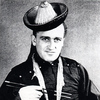A gilt copper alloy figure of Amitayus, Qing dynasty, Qianlong (1736-95).
Incised with a cyclical gengyin date corresponding to 1770, and of the period. The figure is finely cast seated in dhyanasana on a rectangular plinth with waisted foliate corners draped in front with a long cloth with a flower head at its center and it should have been fitted with a separate flame-bordered mandorla/nimbus but it is now missing. The figure wears a jeweled necklace and robes draped over the left shoulder. The face is cast with a pensive expression beneath hair pulled up into an elaborate coiffure behind a five-point foliate crown. Height 18,5 cm.
Vase, part of crown and nimbus/mandorla missing.
Alkuperä - Provenienssi
Formerly in the collection of Danish Archaeologist, Ethnographer, Art Collector and Museum Director Werner Jacobsen (1914-79). Jacobsen studied archeology and participated 1938-39 in the Danish Royal Geografic Societys Expedition to Mongolia under the lead of Henning Haslund-Christensens.
During the years 1946-59 he lived in India and Nepal and acquired many pieces for National Museum in Denmark, The Royal Library, the Moesgård Museum and himself. He set up a scientific center in Kathmandu, Nepal and later in Denmark where he organized all the material and information he had gathered.
In 1940-45 he was employed the Danish National Museum, in 1961 he became Museum Director for the Etnografic Collection. 1963-78 he was the head of the information and educational Department at the Museum. The collection was acquired from Werner Jacobsen as a whole when he sold it to gather funds for new expeditions. Thence by descent to the present owner.
Muut tiedot
Many similar statues of Amitayus were made, especially in the Qing dynasty, because it was believed that the merit gained by commissioning multiple images would increase the life of both the donor and the person to whom they were given. The Qianlong emperor had a great number made for his and his mother's birthdays. The inscription reads 'respectfully made in the .. year of the Qianlong reign of the great Qing dynasty'.












































